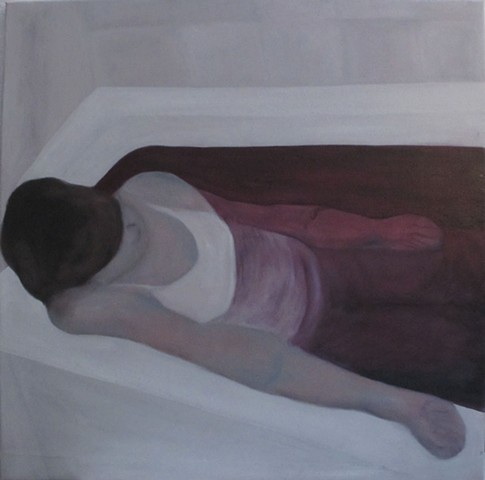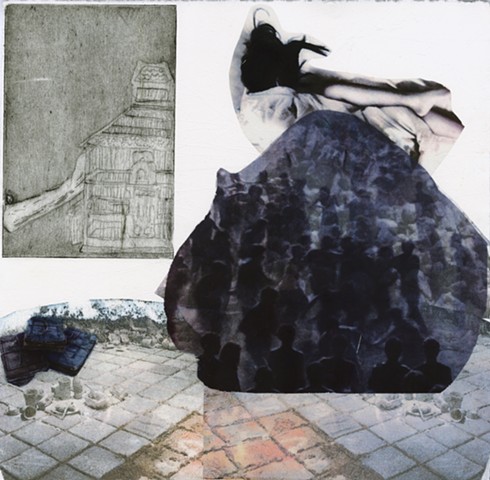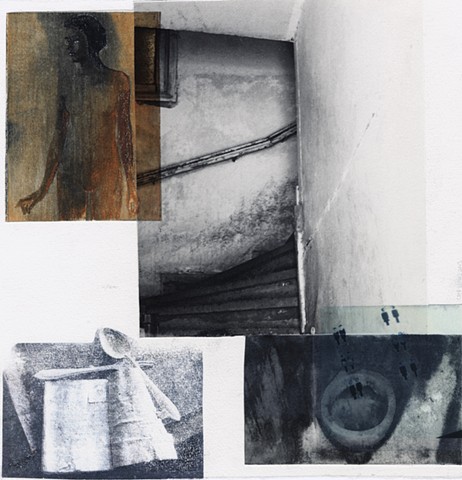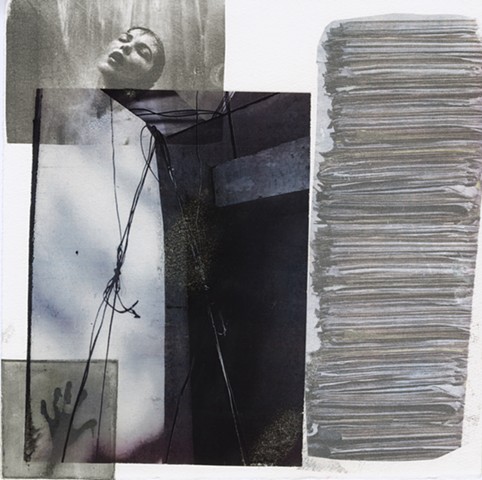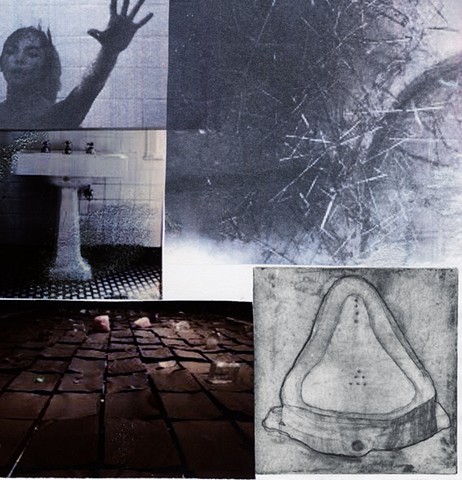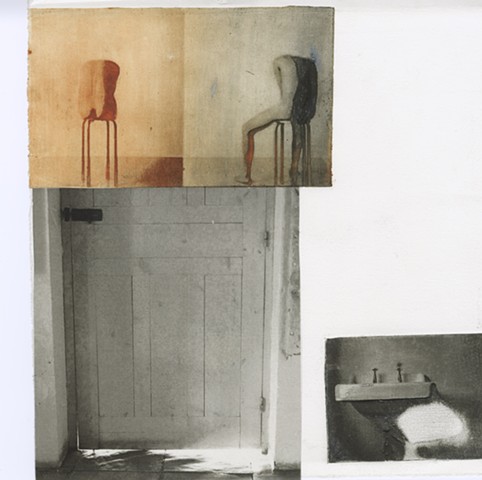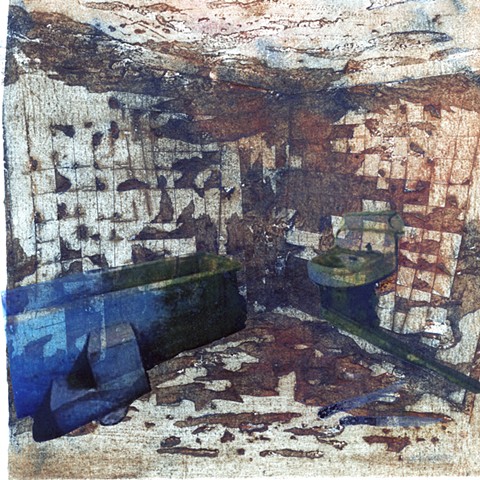AMORT
Carmen Hurtado imagines: amort or imaginary suicide / painting and mix media.
Carmen gives us the freedom to choose between two names. On the one hand, love-t or a-mort , the result of the semantics of the intersection between two words, a literary device known as chiasma.
The other, imaginary suicide, perpetrated by a female figure submerged in the water of a bathtub dyed red. Death for love or love for death?
An oil on canvas and 6 combinations of small format with a mixed technique of photoengraving, transfer and collage to consider putting an end to existence as we know it.
Losing the link that we have forged with the world and, therefore, leaving ourselves. Is it a contradiction to imagine love through heartbreak and death? Carmen has some words from Schopenhauer in mind: suicide, far from denying the desire to live, strongly reaffirms it.
The suicide loves life to such an extent that he does not want to be a slave to suffering. Say goodbye to pain with freedom and lucidity, in an intimate area, between the walls of the privacy of a bathroom, a place par excellence for cleansing and purification. Drains flush away our dirt and excrement. It is also a sanctuary for the mirror, which returns us to our corporeal dimension and makes us rediscover our own self when contemplating ourselves.
A drop of blood makes us drink the elixir of life. We are flesh, bones, organs and blows. And the blood of a menstruation that marks a change of time and cycle. Loss, pain, but also fertility postulate for the new projects. Of the body and the anima, which are the same thing.
Life arises from aquatic circumstances and always returns to them.
Carmen superimposes and influences graphic images of privacy and nudity in spaces that take on the confinement of a cage, fear of the unknown that is hidden behind closed doors, the absurdity of Duchamp, the horror and psychosis of Hitchkock's frames.
The intimate space recorded with connotations of illness and catharsis.
Seneca wrote: Dying sooner or later is of no importance. And how the Roman philosopher cut his veins in a bathtub by order of Nero and how many Marats and how many Ophelias have lost their lives floating in the primitive fluids? And how many Aphrodites have been born?
How many times a day do we kill ourselves? Leaving everything, leaving given challenges Breton. Let's not run away or give up. We left everything. We wash in the bathwater and leave our old skin behind. Let's start again. Eros and Thanatos. Beginning or end. Construction or destruction. Conscious or unconscious. Freedom to choose between two titles for a work. Or to choose between two instincts, two sides of the same coin. Love and death. I love to love. And if we choose both?
Text: Lourdes Ribé
www.taularasa.wordpress.com
Carmen Hurtado se imagina: amort o suicidio imaginario /pintura y técnica mixta.
Carmen nos otorga la libertad escoger entre dos nombres. Por una parte, amor-t o a-mort , el resultado de la semántica de la intersección entre dos palabras, un recurso literario conocido como quiasma.
El otro, el suicidio imaginario, perpetrado por una figura femenina sumergida en el agua de una bañera teñida de rojo. ¿La muerte por amor o amor por la muerte?
Un óleo sobre lienzo y 6 combinaciones de pequeño formato con técnica mixta de fotograbado, transferencia y collage para considerar poner fin a la existencia tal y como la conocemos.
Perder el vínculo que hemos forjado con el mundo y, por lo tanto, salir de nosotros mismos. ¿Es una contradicción imaginar el amor a través del des-amor y la muerte? Carmen tiene en mente unas palabras de Schopenhauer: el suicidio, lejos de negar los deseos de vivir, la reafirman enérgicamente. El suicida ama la vida hasta tal punto que no quiere ser esclavo del sufrimiento. Se despide del dolor con, libertad y lucidez, en una zona intima, entre las paredes de la privacidad de un cuarto de baño, lugar por excelencia de la limpieza y purificación. Los desagües lanzan lejos nuestra suciedad y excrementos. Es también un santuario para el espejo, que nos retorna a nuestra dimensión corporal y nos hace reencontrarnos con el propio yo al contemplarnos.
Una gota de sangre nos hace beber el elixir de la vida. Somos carne, huesos, órganos y golpes. Y la sangre de una menstruación que marca un cambio de tiempo y de ciclo. Pérdida, dolor, pero también fertilidad postulan por los nuevos proyectos. Del cuerpo y el anima, que son la misma cosa.
La vida surge de circunstancias acuáticas y vuelve siempre a ellas.
Carmen superpone y incide en imágenes graficas de la privacidad y desnudez en espacios que adquieren el enclaustramiento de una jaula, miedo a lo desconocido que se oculta detrás de puerta cerrada, el absurdo de Duchamp, el horror y psicosis de fotogramas de Hitchkock. El espacio íntimo grabado con connotaciones de enfermedad y de catarsis.
Séneca escribió: Murir antes o después no tiene nada de importancia. Y como el filósofo romano se corta las venas dentro de una bañera por orden de Neron y cuantos Marats y cuantas Ofelias han perdido la vida flotando en los fluidos primitivos? Y ¿cuántas Afroditas han nacido?
¿Cuántas veces al día nos matamos a nosotros mismos? Dejarlo todo, dejar dada nos desafía Breton. No huyamos ni abandonemos. Lo dejamos todo. Nos lavamos en el agua de la bañera y dejamos nuestra piel vieja. Comencemos de nuevo. Eros y Tánatos. Principio o al fin. Construcción o destrucción. Consciente o inconsciente. Libertad de escoger entre dos títulos para una obra. O de escoger entre dos instintos, dos caras de la misma moneda. Amor y muerte. Me encanta amar. ¿Y si elegimos los dos?
Texto:Lourdes Ribé
www.taularasa.wordpress.com
